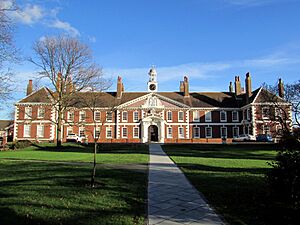Morden College facts for kids
Quick facts for kids Morden College |
|
|---|---|
 |
|
| Type | Residential home |
| Location | Blackheath, London, England |
| Built | 1695-1702 |
| Architect | Christopher Wren |
| Governing body | Charity |
|
Listed Building – Grade I
|
|
| Official name: Morden College | |
| Designated | 19 October 1951 |
| Reference no. | 1289879 |
| Lua error in Module:Location_map at line 420: attempt to index field 'wikibase' (a nil value). | |
Morden College is a special charity that has offered homes and care in Blackheath, London, for more than 300 years. It was started by a kind person named Sir John Morden in 1695. He wanted to create a home for "poor Merchants" – people who had lost their money. The famous architect Sir Christopher Wren is sometimes said to have designed the buildings.
The first buildings at Morden College were made for 40 single or widowed men. Over time, the college grew. Today, Morden College is a very important historic building, known as a Grade I listed building. It works as a retirement home for older people. In October 2023, a new part of the college, the John Morden Centre, won a big award for its amazing design, called the Stirling Prize.
Contents
History of Morden College
How it Started
The college was founded by Sir John Morden in 1695. He was a philanthropist, which means he loved to help people. He wanted to create a home for merchants who had lost their money. This included those who lost their wealth because of dangers at sea or other problems while trying to earn a living.
The college was built on a piece of land called the Wricklemarsh estate. Sir Christopher Wren is often given credit for the design. However, much of the actual building work was done by Edward Strong, who was a master builder.
The first buildings were planned to house 40 men who were either single or widowers. A writer named Daniel Lysons described the college in 1796. He said it was a large brick building with stone details. It formed a square shape with covered walkways around it. Above the front entrance were statues of Sir John Morden and his wife. Inside, there were paintings of them and of Queen Anne. The chapel had the Morden family's coat of arms and a list of gifts given to the college.
Early Management and Gifts
For many years, the college was managed by trustees from the Turkey Company. This was a group of merchants who traded with countries in the Middle East.
Sir John Morden placed twelve merchants in the college while he was still alive. He passed away in 1708. In his will, he left money and land to the college. His wife, Lady Morden, continued his work. However, she had to reduce the number of residents to four for a while. When she passed away in 1721, the college received all the money and land Sir John had left.
To live at the college, people had to be over 50 years old. They also had to be single or widowers and members of the Church of England. They received a small monthly payment. The college had enough rooms for 30 people. New residents were chosen once a year if there were empty spots. Seven trustees from the Turkey Company managed the college and chose the residents.
Many other people also gave money to the college over the years. These gifts helped the college continue its important work. Here are some of the people who donated:
| Year | Person | Value of gift |
|---|---|---|
| 1721 | Lady Morden | £100 |
| 1723 | Sir Charles Cooke | £100 |
| 1729 | Sir Peter Delmé | £100 |
| 1751 | William Hanger, Esq | £100 |
| 1751 | Richard Chiswell, Esq | £100 |
| 1752 | Thomas Cooke, Esq | £114 |
| 1764 | Francis Levett, Esq | £200 |
| 1772 | Richard Chiswell, Esq | £200 |
| 1774 | Richard Pyke, Esq | £1,000 |
| 1774 | John March, Esq | £500 |
| 1775 | Sir Gregory Page | £300 |
| 1788 | John Jamet, Esq | £50 |
Changes Over Time
From 1827 to 1884, trustees from the British East India Company helped manage the college. William Astell was the first trustee from this company. Later, John Lubbock was the Chairman of the Trustees from 1873 to 1889.
In the 20th century, the rules for who could live at Morden College changed. This allowed women and married couples to become residents. Several new buildings were also added to the college.
Today, Morden College is a Grade I listed building. This means it is a very important historical site that is protected. It continues to serve as a retirement home for older people. The college also manages other homes in Blackheath and in Beckenham.
In October 2023, the John Morden Centre, a day centre at Morden College, won the Stirling Prize for architecture. This award recognized its excellent design.
In November 2023, a company called Galliard Homes, working with a partner from Singapore, bought a large piece of land called Morden Wharf in Greenwich. They bought it from Morden College and another partner.
People Connected to Morden College
Chaplains
- Moses Browne (1703–1787) served as a chaplain here.
Notable Residents
Some well-known people have lived at Morden College:
- Henry Newton Knights (1872–1959), who was a Member of Parliament for the Conservative Party, passed away here.
- Ann Moss, FBA (1938–2018), a scholar who studied French literature, also passed away here.


